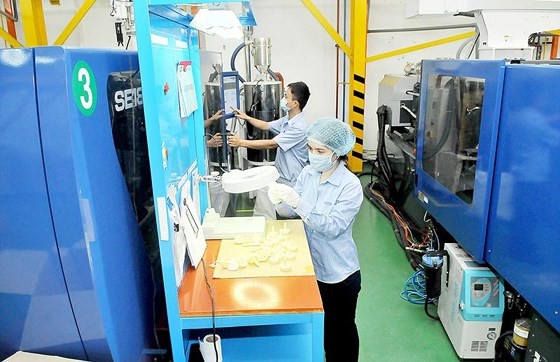
Mr. Le Hoang Tai, deputy head of the Vietnam Trade Promotion Agency under the Ministry of Industry and Trade, affirmed that global value chain has been undertaking steps in production network and making use of commercial advantages. Participating in the global value chain also helps businesses to speed up industrialization. Especially, it will also help businesses to develop their brands and gain positions in global market. Although Vietnam has signed many economic agreements which pave the way for Vietnamese firms to enter global market, Vietnamese firms have not made breakthrough yet.
Meanwhile, potential for investment in production in Vietnam and participation in global value chain for sustainable development is great. Samsung Corporation alone needs about 500 suppliers from now to 2020. However, Vietnamese firms have not been able to take advantage of this opportunity, causing localization ratio to be extremely low. This year, only 35 Vietnamese firms are first-grade suppliers for Samsung. Currently, there are a few enterprises qualified to participate in the supply chain.
Mr. Ron Ashkin, director of the USAID program, said that the amount of goods of small-and-medium-sized enterprises (SMEs) and foreign-direct-investment (FDI) companies accounted for up to 70 percent of total exports of Vietnam with US$244 billion. However, most FDI companies cooperated with foreign suppliers. Meanwhile, although SMEs make up for 98 percent of total number of businesses in the country, only 21 percent of them participated in foreign supply chain whereas that of other countries in the ASEAN, including Thailand and Malaysia, was 30 percent and 46 percent respectively.
The country’s localization ratio is also low with average ratio of around 33 percent. Last year, FDI companies in Vietnam had to import 47 percent of input materials from foreign suppliers.
Vietnamese market is in need of supporting enterprises. However, if local firms fail to meet the demand, they will gradually lose the market. There are several large firms having built factories in Vietnam, comprising of Samsung and LG. This is the opportunity for Vietnamese enterprises to join the global value chain. Foreign investors also want local enterprises to take part in the global value chain with them because using products of local firms will reduce risks when importing supporting products, such as long shipping times, late delivery and defective products which affects greatly their production lines.
In addition, firms that invested in Vietnam will not be able to make use of reasonable production expenses in Vietnam and advantages of preferential export tariffs and market opening to easily participate in the global supply chain. While potential value of localization in export via global value chain of Vietnam is US$115 billion, the country has great potential to boost global supply chain to around $58 billion.
The difficulty of SMEs in Vietnam when participating in the global value chain is that they are not able to meet the required prices due to high input costs, ineffective production, lack of suitable management standards, lack of distribution channel and limited commercial ability. In order to deal with this difficulty, firms should improve their global competitiveness by acquiring international standards in quality and strengthen abilities in trade, administration and connection.
























